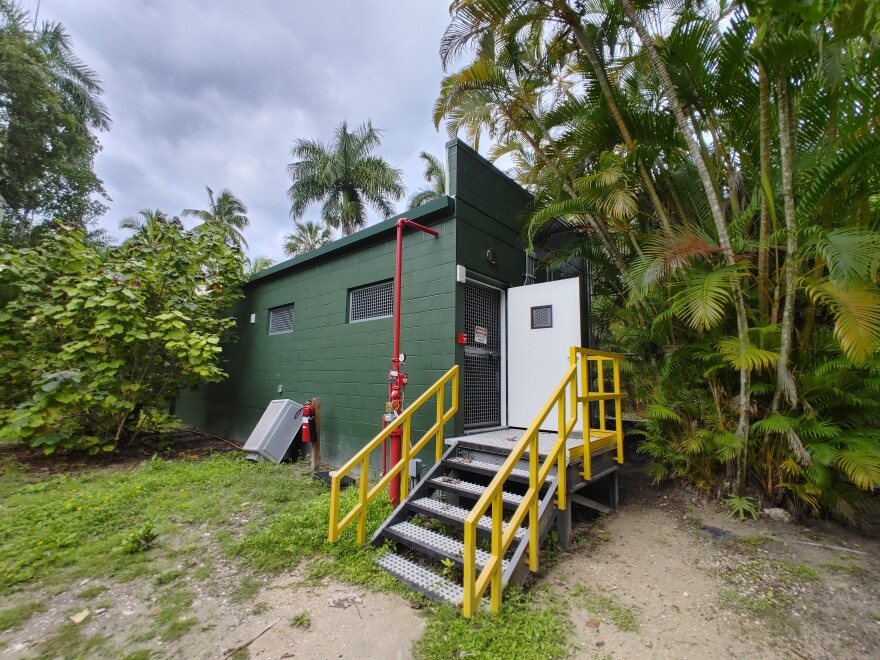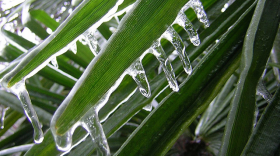Many stories out of Hurricane Ian have been stories of loss and devastation. But the Naples Zoo, a pocket of delight on almost any day, is a spot in Southwest Florida that came through the storm intact in all the important ways. Not one animal was lost or even injured in the brutal Category 4-plus hurricane that barreled through town.
Staff attributes that outcome to being prepared, and having invested in the animals’ safety for years.
Director of Gardens and Grounds Danielle Green was one of 12 staffers who rode out the storm at the zoo. She describes how she and her colleagues handled September 28, the day the hurricane roared in.
“We arrived here Wednesday morning at 7:30am,” Green said. “We did some rounds to check on animals, pull diets, any last minute preparation things just to kind of button everything back down, split up into teams, report back to the hospital, monitor the storm throughout the day. In the late afternoon, early evening Wednesday, we did send out a couple of additional teams. We didn't really get as far as we would have liked just because the conditions were what they were. We noticed we had a couple trees down, the wind was still kicking up, it was getting dark. And so then, first thing Thursday morning, I think it was about maybe 7:30 or 8 o'clock, we went out and then started our assessments and pretty much walked every inch of the property.”
The hospital that Green refers to is the Glass Animal Hospital, which opened on zoo grounds in November 2019. It is fully hurricane proof, built to the same standards required by Collier County for a condo or a home for people. It is a tremendous improvement over the infrastructure that was in place for Hurricane Irma in 2017 when two greater kudu—a type of antelope—did not survive the stress of the storm.

For Hurricane Ian, the animals were taken to the hospital and other hurricane-proof buildings on site well before the storm made landfall. That way, they could stay clear of the 3 feet of water staff observed rushing through the property. And, Green says, the plan would have been the same no matter the severity of the storm, from Category 1 to Category 5.
Courtney Jolly is Director of Marketing and Public Relations at the zoo.
“A lot of the show area, everything around the front side of the zoo is very low,” she said. “It was built in the 70s. So it's way below flood level where it should be. So we actually evacuated that whole area. And any of the smaller animals ended up over in the hospital. And then some other animals, we have a newer bathroom down by the giraffes, we actually had cranes in the bathroom. But it's a hurricane-proof building. It was built to hurricane code and standards. And so that's where they were safest was to be in that building instead of in a crate or something. They just had free rein of that space, which was good for them, safe for them. And then the majority of everybody else, all the big cats stayed in their concrete dens like this one and Panther and anteater actually came over and stayed with bear in his den because he doesn't have a concrete den. So it was a lot of shifting moving animals around so that everybody had a safe place to go. Thankfully, we moved Honey Badgers, their whole exhibit was underwater completely. So they actually rode the storm out in a different building on the other side of the zoo. I believe they were in Panther.”


The hospital was built with a full building generator, so the staffers who rode out the storm had power and water, and the animals’ food could be kept safely chilled.
The primates even got health exams, including dental, eyes, and blood work, while they were in the hospital. Everyone got a clean bill of health.
Courtney Jolly again:
“But you know, we plan for things like this,” she said. “And even so, you know, it's still a lot of work. It's still a lot of moving parts, but there's a plan in place that at least helps us execute it better.”
When the storm finally passed, the zoo was closed to guests for 17 days while staff cleaned up debris and damage to buildings. The animals were moved back to their habitats, and generally picked up right where they left off, healthy as they were before the storm.
Director of Gardens and Grounds Danielle Green attributes it to being ready months before the storm was forecasted.
“Really, it’s preparation,” she said. “Ahead of time, having those relationships within the community. On Friday, I was at a tree arborists workshop up in Tampa, and I immediately called all my vendors and said, I need you on standby. I need a lift delivered. I need a grapple delivered. I need some equipment. Touching base with my debris vendor – Hey, buckle down, I’ll be in touch as soon as things calm down. So having all those pieces in place well ahead of time, having those conversations with people, not just an email, because you know after that, the communications are extremely difficult. Making sure you have everyone’s number.”
Thanks to that preparation, by now the zoo is well back to normal. Athena the panther strolls her exhibit gracefully. Jumanji the giraffe accepts a few romaine leaves, and visitors amble by, happy to see all the animals back in their exhibits, safe and healthy.









